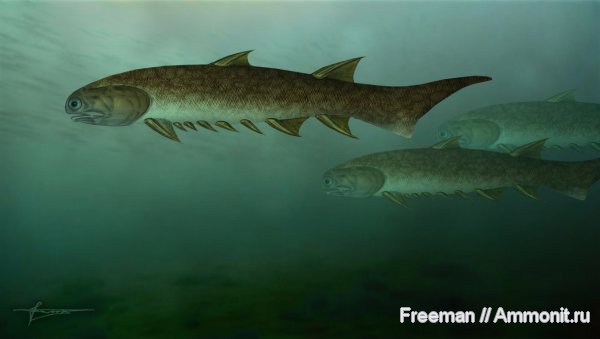Acanthodii : Overview

The Acanthodian Euthacanthus, Early Devonian of Scotland. Traditionally classified as a Climatiiforme, cladistic analysis by Brazeau 2009 places it between Ischnacanthus and the higher Acanthodiformes. An animal like this might have been typical of the common ancestror of all higher fish (but not this actual species, which lived several tens of millions of years later the the evolutionary divergence would hacve occured). Life reconstruction © Mikhail Tikhonov, original url |
In our review of vertebrate evolution, the Acanthodii were originally to have been included, as they were in the previous iteration of Palaeos, in a unit called Teleostomi. Except that they have tuerned out, it seems, to be the common ancestors of bony fish (and hence also, land animal which evolved from those fish) and sharks. Or, to be more precise, the paraphyleticgrade from which the other groups evolved (Brazeau 2009). This puts those little paleozoic fishes in the same category as rhyniophytes, labyrinthodonts, captorhinomorphs, thecodonts, and many other ancestral groups, the members of each of which are very similar to each other morphologically, but which are also each ancestral to different lineages. And while, contra to the hopes of Intelligent Design advocates, this in no way threatens the validity of either cladistics or Darwinism, it does show the problems that result from inclusion of supra-specific taxa in cladistic trees (of course we do this all the time here, which makes the trees featured on Palaeos dendrograms or supertrees rather than true cladograms). This is because cladistic methodology requires individual taxa, just as evolutionary systematics is best suited to supra-generic taxa. And hopefully future studies will reveal more detailed information about the evolutionary relationships of our fishy ancestors. MAK110930, 111027
page last modified MAK111027
